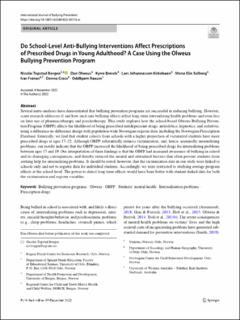| dc.contributor.author | Borgen, Nicolai T. | |
| dc.contributor.author | Olweus, Dan | |
| dc.contributor.author | Breivik, Kyrre | |
| dc.contributor.author | Kirkebøen, Lars Johannessen | |
| dc.contributor.author | Solberg, Mona Elin | |
| dc.contributor.author | Frønes, Ivar | |
| dc.contributor.author | Cross, Donna | |
| dc.contributor.author | Raaum, Oddbjørn | |
| dc.date.accessioned | 2023-01-20T13:42:30Z | |
| dc.date.available | 2023-01-20T13:42:30Z | |
| dc.date.created | 2022-12-22T13:36:57Z | |
| dc.date.issued | 2022 | |
| dc.identifier.issn | 2523-3653 | |
| dc.identifier.uri | https://hdl.handle.net/11250/3044995 | |
| dc.description.abstract | Several meta-analyses have demonstrated that bullying prevention programs are successful in reducing bullying. However, scant research addresses if and how such anti-bullying efforts affect long-term internalizing health problems and even less on later use of pharmacotherapy and psychotherapy. This study explores how the school-based Olweus Bullying Prevention Program (OBPP) affects the likelihood of being prescribed antidepressant drugs, anxiolytics, hypnotics, and sedatives, using a difference-in-difference design with population-wide Norwegian register data, including the Norwegian Prescription Database. Generally, we find that student cohorts from schools with a higher proportion of victimized students have more prescribed drugs at ages 17–22. Although OBPP substantially reduces victimization, and, hence, assumedly internalizing problems, our results indicate that the OBPP increased the likelihood of being prescribed drugs for internalizing problems between ages 17 and 19. Our interpretation of these findings is that the OBPP had increased awareness of bullying in school and its damaging consequences, and thereby reduced the mental and attitudinal barriers that often prevent students from seeking help for internalizing problems. It should be noted, however, that the victimization data in our study were linked to schools only and not to register data for individual students. Accordingly, we were restricted to studying average program effects at the school level. The power to detect long-term effects would have been better with student-linked data for both the victimization and register variables. | en_US |
| dc.language.iso | eng | en_US |
| dc.publisher | Springer | en_US |
| dc.rights | Navngivelse 4.0 Internasjonal | * |
| dc.rights.uri | http://creativecommons.org/licenses/by/4.0/deed.no | * |
| dc.title | Do School‑Level Anti‑Bullying Interventions Affect Prescriptions of Prescribed Drugs in Young Adulthood? A Case Using the Olweus Bullying Prevention Program | en_US |
| dc.type | Journal article | en_US |
| dc.type | Peer reviewed | en_US |
| dc.description.version | publishedVersion | en_US |
| dc.rights.holder | Copyright The Author(s) 2022 | en_US |
| cristin.ispublished | true | |
| cristin.fulltext | original | |
| cristin.qualitycode | 1 | |
| dc.identifier.doi | 10.1007/s42380-022-00150-w | |
| dc.identifier.cristin | 2097003 | |
| dc.source.journal | International Journal of Bullying Prevention | en_US |
| dc.identifier.citation | International Journal of Bullying Prevention, 2022. | en_US |

